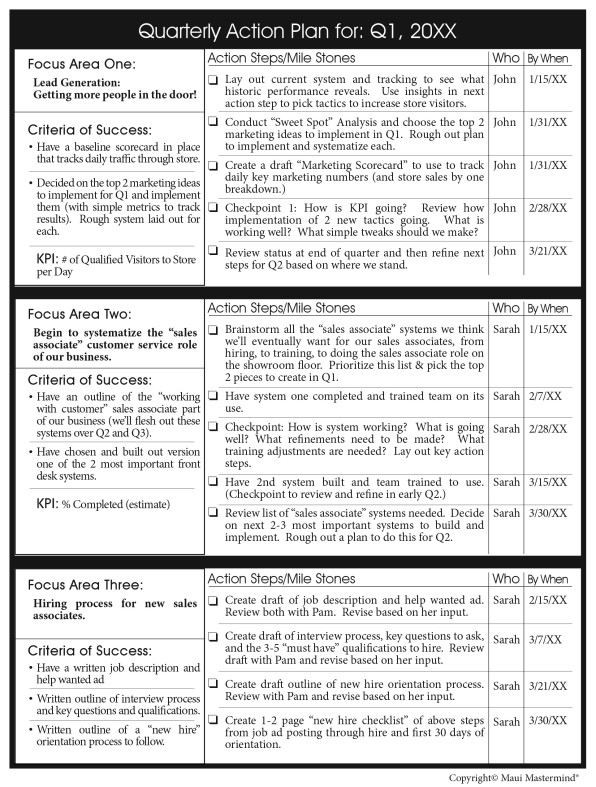The One-Page Cheat Sheet To Your Most Productive 90 Days Ever
Dr. Challa wasn’t starving for opportunity, he was drowning in it. He was bright, confident, and empathetic. Not only did he have great bedside manners, but he was also a savvy entrepreneur who’d grown his medical practice to nine locations in five cities.
But Challa’s ballooning options were starting to exceed his abilities to chase them all–not to mention his team’s. In theory, he could open up two more offices, acquire a small dermatology practice, add medical dispensaries to several of his locations, start a medical spa retail location–the list went on. As it grew longer, Challa’s productivity was beginning to slip, and his staff was struggling to keep up with his energy and constant stream of new ideas. The ideas were solid, but their sheer volume outpaced any possibility of implementing them all.
Personal productivity and team productivity are unavoidably linked. And while companies often sit down to draw up quarterly action plans, individuals rarely do. But they should. In fact, 90 days is the perfect unit of time to make headway on your big-picture goals–and to give them the focus they need, so you and your team don’t get too overwhelmed.
Most of the projects that threaten to derail our productivity when we finally start on them have longer timelines than we imagine, making them difficult to break down into daily or weekly actions. But done right, a 90-day sprint is enough to get meaningful units of work done that collectively bring you closer to your long-term goals. And it’s still short enough that you can frequently course-correct anytime things threaten to veer off track.
Here’s an example of the simple, one-page worksheet that can help you manage that balancing act over the next quarter–but you can draw a quick grid on a blank sheet of paper and it works just as well:

Step 1: Pick Three Things To Focus On
Start by choosing a maximum of three “focus areas” for the coming quarter. Of course you’ll still have to take care of your day-to-day work, too, but these focus areas should rise above that–they’re where you think your time, talent, attention, and money are best spent on longer-term objectives during the coming quarter. Your day-to-day tasks will keep you afloat, while your focus areas will propel you ahead.
For instance, you may decide that your focus areas are on increasing your lead flow, improving your sales conversion system, speeding up your collections cycle, or making a specific key hire.
Why cap it at three? Because too many top priorities means you have no top priorities. Ninety days comes fast, and if you spread yourself or your team too thin, you’ll find that you do more things partially instead of fully, leaving a bunch of half-finished projects by the time the next quarter rolls around. You don’t want that. Not only is this a waste of resources, but it’s also frustrating for your team, who will appreciate having actually achieved something–not just started it–by the time your 90-day sprint is over.
Step 2: Decide How You’ll Judge Your Progress
Now that you’ve picked your three focus areas for the quarter, it’s time to clarify your criteria of success for each one. This can be tricky. First, be ruthlessly realistic about what’s possible within just three months, and second, look for concrete signs of progress. It’s important to pin down criteria that are as objectively and quantitatively measurable as possible.
So take your time laying out the criteria of success for each focus area. You’re not only defining what success will look after 90 days, but by giving yourself a yardstick to measure yourself against as you go, you’re also deciding which changes you’ll have to make to your ordinary workday. That may mean blocking out 30 minutes each day to work exclusively on one of your focus areas. Or it might mean delegating a daily task to a colleague this quarter, so you can spend more time on something else. But you won’t know which steps to take until your criteria is in place.
Step 3: Identify Which Steps To Take (And Who’s Going To Take Them)
Now that you’ve identified your top three focus areas and your criteria for achieving them, now it’s time to lay out how to get you there. In order to keep your plan to one page, you’ll likely have to break each focus area down into five to seven action steps and milestones. Your plan needs to be detailed enough to guide your actions but not so detailed that you feel overwhelmed or lose yourself in the minutiae.
This is the part where you decide which of these steps you can take and which ones you’ll need others to help you with. Divide and conquer. If one of your focus areas is more of a professional-development goal, the main work will fall to you; if another focus area describes a business goal, it’s perfectly fine to enlist your team. When it comes to the latter, assign a specific team for executing just one action step over the 90-day sprint. Remember: The whole point is to boost productivity, not just add more work to everyone’s plate.
I handed this one-page plan to Dr. Challa two years ago, and he’s used it with his team each quarter. Since then, his practice has increased revenues by $4 million and is more focused and organized than ever before. You can’t do everything at once. But you can probably do the things that really matter more productively than you currently are–all within the next 90 days.
David Finkel is coauthor of the best-selling SCALE: 7 Proven Principles to Grow Your Business and Get Your Life Back.
Fast Company , Read Full Story
(375)














